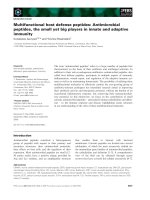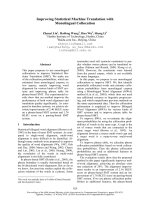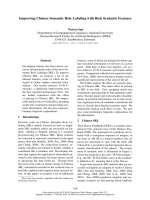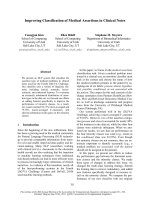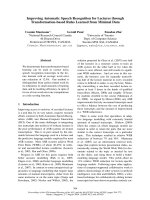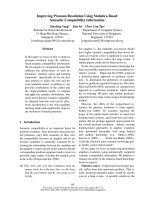báo cáo khoa học: "Improving hypertension management through pharmacist prescribing; the rural alberta clinical trial in optimizing hypertension (Rural RxACTION): trial design and methods" ppsx
Bạn đang xem bản rút gọn của tài liệu. Xem và tải ngay bản đầy đủ của tài liệu tại đây (292.53 KB, 9 trang )
STUDY PROT O C O L Open Access
Improving hypertension management through
pharmacist prescribing; the rural alberta clinical
trial in optimizing hypertension (Rural RxACTION):
trial design and methods
Theresa L Charrois
1
, Finlay A McAlister
2,3
, Dale Cooney
4
, Richard Lewanczuk
2
, Michael R Kolber
2
,
Norman RC Campbell
5
, Meagen Rosenthal
3
, Sherilyn KD Houle
3
and Ross T Tsuyuki
2,3*
Abstract
Background: Patients with hypertension continue to have less than optimal blood pressure control, with nearly
one in five Canadian adults having hypertension. Pharmacist prescribing is gaining favor as a potential clinically
efficacious and cost-effective means to improve both access and quality of care. With Alberta being the first
province in Canada to have independent prescr ibing by pharmacists, it offers a unique opportunity to evaluate
outcomes in patients who are prescribed antihypertensive therapy by pharmacists.
Methods: The study is a randomized controlled trial of enhanced pharmacist care, with the unit of randomization
being the patient. Participants will be randomized to enhanced pharmacist c are (patient identification, assessment,
education, close follow-up, and prescribing/titration of antihypertensive medications) or usual care. Participants are
patients in rural Alberta with undiagnosed/uncontrolled blood pressure, as defined by the Canadian Hyperte nsion
Education Program. The primary outcome is the change in systolic blood pressure between baseline and 24 weeks
in the enhanced-care versus usual-care arms. There are also three substudies running in conjunction with the
project examining different remuneration models, investigating patient knowledge, and assessing health-resource
utilization amongst patients in each group.
Discussion: To date, one-third of the required sample size has been recruited. There are 15 communities and 17
pharmacists actively screening, recruiting, and following patients. This study will provide high-level evidence
regarding pharmacist prescribing.
Trial Registration: Clinicaltrials.gov NCT00878566.
Background
The problem
Patients with hypertension continue to have less than
optimal blood pressure control. Nearly one in five Cana-
dians adults–about 4.6 million people between the ages
of 20 and 79–have high blood pressure [1]. Almos t 50%
of patients between the ages of 60 and 79 had a diagno-
sis of hypertension, with the highest rates of hyperten-
sion in elderly women [1,2]. In the United States and
Canada, approximately 50% and 35%, respectively, of
patients with hypertension are not controlled. These
numbers increase to over 60% in patients with diabetes
[3,4]. Although awareness and control of hypertension
have improved significantly in the last 20 years, there
still is a large gap in care.
The problem in rural communities
Care of patients with chronic diseases living in rural
communities is sometimes difficult given the shortage of
rural physicians and the lack of access to specialty care
and other healthcare professionals. There is also evi-
dence to suggest that practice guidelines may be imple-
mented to a lesser extent in rural communities [5, 6].
* Correspondence:
2
Department of Medicine, University of Alberta, Edmonton, Alberta, Canada
Full list of author information is available at the end of the article
Charrois et al. Implementation Science 2011, 6:94
/>Implementation
Science
© 2011 Charrois et al; licensee BioMed Central Ltd. This is an Open Access article distributed under the terms of the Creative Commons
Attribution License ( which permits unrestricted use, distribution, and reproduction in
any medium, provided the original work is properly cited.
This provides an excellent opportunity for a multidisci-
plinary shared-care approach to screening, diagnosis,
management, and f ollow-up of patients with hyperten-
sion [7].
Pharmacists helping to solve the problem
There have been a nu mber of interv entions by pharma-
cists to help close these gaps in hy pertension manage-
ment [8,9]. In a recently published study on physician
and pharmacist collaboration in a community medical
office, there was an adjusted mean change in systolic
blood pressure (SBP) of -12.0 mm Hg at six months and
an absolute improvement in blood pressure (BP) control
rates of 34% (from 30% in usual care to 64%) [10]. A
systematic review conducted by the same group [11]
invest igated the effects of team-based care for hyperten-
sion. Pharmacist recommendations to the physician
decreased overall SBP by 9 mm Hg.
In a recently completed study by our group, Impro v-
ing blood pressure management in patients with dia-
betes study (SCRIP-HTN), a community pharmacist and
nurse intervention (in which the treatment team moni-
tored patients’ blood pressures and faxed guideline-con-
cordant treatment recommendations to their primary
care physicians if they were above target) produced a
5.6 mm Hg greater decrease in SBP over 24 weeks com-
pared to usual care in patients with diabetes and poorly
controlled blood pressure [12]. Despite the improvement
in mean blood pressure, only half of the patients
reached their blood pressure goal. One potential expla-
nation for this is that traditional pharmacist care can
only go so far with recommending appropriate therapy
(i.e., there is a ceiling effect based on whether or not the
physician prescribes the recommended therapy).
As healthcare costs worldwide increase, pharmacist
prescribing is gaining favor as a potentially clinically effi-
cacious and cost-effective means to improve both access
and quality of care [13]. Pharmacist prescribing is
defined differently depending on the region; it can range
from prescribing by protocol to independent prescribing.
The Canadian province of Alberta has been a pioneer in
the area of independent pharmacist prescribing by being
the first jurisdiction in Canada to enact legislation for
such. Pharmacists in Alberta now have the ability to
apply for additional prescribing authorization. This
authorization allows them to prescribe for minor self-
limited or self-diagnosed conditions, to modify a pre-
scription written by another prescriber, or to undertake
comprehensive drug therapy management, which can
include independent initiation of drug therapies [14].
Pharmacist prescribing is a relatively recent innova-
tion, and as such, there i s little evidence about its clini-
cal or economic impacts. For instance, work in the
United Kingdom has focused generally on attitudes
towards pharmacist prescribing and on the value of
training programs for pharmacist prescribing authority
[15-17].
With Alberta being the first province in Canada to
allow in dependent prescribing by pharmacists, it offers a
unique opportunity to evaluate outcomes in patients
who are prescribed antihypertensive therapy by
pharmacists.
Methods
Study overview
The study is a randomized controlled trial o f enhanced
pharmacist care, with the unit of randomization being
the patient. Participants are randomized to either
enhanced pharmacist care (patient identification, assess-
ment, education, close follow-up, and prescribing/titra-
tion of antihypertensive medications) or usual care
(Figure 1). Due to the nature of the intervention, blinding
of patients and practitioners is not possible, although
outcomes will be adjudicated in a blinded fashion.
The p rimary objective is to evaluate the effect of
enhanced pharmacist care on SBP in patients with
poorly controlled hyp ertension in the rural setting. Sec-
ondary objectives include the number of patients at
their BP target at 24 weeks, the number of new antihy-
pertensive medication starts, the number of antihyper-
tensive dosage changes (increases and decreases in
dose), the number of antihypertensive medication
changes, and the number of n ew prescriptions for
aspirin and cholesterol medications.
Patients
Participants are patients in rural Alberta with undiag-
nosed or uncontrolled BP as defined by the Canadian
Hypertension Education P rogram (CHEP) [18]. Pharma-
cists screen patients using the criteria in Table 1, as
adapted from the CHEP guidelines for the management
of hypertension by pharmacists [19].
Patients are included if they meet one of th e following
criteria:
• Overall average (after two visits in undiagnosed
patients without macrovascular target organ damage,
diabetes [DM], or chronic kidney disease [CKD]) SBP
≥180 mm Hg or diastolic BP (DBP) ≥110 mm Hg
• Overall average (after two visits in patients with
undiagnosed hypertension with macrova scular target
organ damage) SBP ≥140 mm Hg or DBP ≥90 mm Hg
• An established diagnosis of hypertension above tar-
get B P, SBP ≥140 mm Hg (≥130 with DM or CKD), or
DBP ≥90 mm Hg (≥80 with DM or CKD)
• Overall average (after five visits for those without
macrovascular target organ damage, DM, or CKD and
without an existing hypertension diagnosis) SBP ≥140
mm Hg or DBP ≥90 mm Hg
Charrois et al. Implementation Science 2011, 6:94
/>Page 2 of 9
Screening visits:
- 2-5 screening visits
or
- 2 screening visit ± HBPM
Identify patients through
pharmacy records
Consent
Enhanced care
n=250
Usual care
n=90
Follow up q4weeks until at target
for 2 visits, then q3months
Randomized
Follow-up at 12 weeks
Final Visit – 24 weeks
Fee for visit
(Figure 2)
n=125
Payment for
performance
(Figure 2)
n=125
Randomized
Final Visit – 24 weeks
Figure 1 Study Flow Diagram. Flow diagram of randomization and follow-up of patients based on group assignment. Patients in enhanced
care are followed up more closely until target blood pressure is reached. Patients randomized to usual care only have two follow-up visits.
(HBPM = home blood pressure monitoring, q4 weeks = every 4 weeks, q3 months = every 3 months).
Charrois et al. Implementation Science 2011, 6:94
/>Page 3 of 9
• Overall average (after seven days of twice-daily home
BP monitoring for those without macrovascular target
organ damage, DM, or CKD and w ithout an existing
hypertension diagnosis) SBP ≥135 mm Hg or DBP ≥85
mm Hg
These inclusion criteria are based on the CHEP cri-
teria for the assessment of patients [ 18]. CKD is defined
as patients with a glomerular filtrat ion rate (as calcu-
lated by the Modification of Diet in Renal Disease equa-
tion) of < 60 mL/min for at least three months [20].
Patient s are exc luded if they are having a hypertensive
urgency (defined as an SBP ≥200 mm Hg or DBP ≥130
mm Hg) or emergency, are unwilling to participate or
sign the consent form, or if the patient is pregnant.
Recruitment
Pharmacists actively screen for potential patients using
the criteria in Table 1. Patients start by attending two
screening visits, separated by two weeks. If their SBP is
between 140-180 mm Hg and their DBP is bet ween 90-
110 mm Hg after the first two screening visits, they will
be invited to either further evaluate their BP by home
BP monitoring or have an additional three screening vis-
its at the pharmacy. The home BP monitors will be lent
to the patients by the pharmacists and are Canadian
Hypertension Society approved devices.
Randomization
After their screening is complete, patients will be invited
to participate. Onc e the patient provides informed writ-
ten consent, the participa nt is randomized (via a centra-
lized secure website to ensure allocation concealment)
in a 2:1 ratio to either enhanced pharma cist care or
usual care (Figure 1) and enrolled by the pharmacist.
The patients randomized to the enhanced pharmacist
care group are further randomized to one of two
payment structures for the pharmacist (fee for visit or
payment for performance, Figure 2) in a 1:1 ratio. The
randomization strategy employs variable blocked rando -
mization stratified by study center.
Intervention
Theintervention(Table2)isbasedupontherecom-
mendations of CHEP [18,19]. Pharmacists assess
patients with regards to BP control and cardiovascular
risk reduction. The pharmacist also reviews the
patient’s current hypertensive therapy regimen and
decides upon the options for improvement of BP con-
trol and implementation of these strategies. Pharma-
cists encourage adherence to antihypertensives. A fax
is sent to th e patient’s primary care physician outlin-
ing the strategies discussed and implemented at the
baseline visit. In some cases, depending o n the proxi-
mity to the physicians, pharmacists may discuss the
changes in person. Patients are followed at four-week
intervals until achievement of target BP for two con-
secutive visits and, thereafter, at three-month inter-
vals until study completion. To support pharmacists,
there is “hotline” access to hypertension experts via
email or telephone. Participating pharmacists submit
questions that are either answered by a member of
the study coordinating center or are forwarded to one
of the hypertension experts on the steering
committee.
Control group
Patients randomized to the control group receive usual
care (which is actually more than typical “usual care ” in
these settings): a wallet card for BP readings and a
pamphlet on BP. Patients are seen at 12 weeks for
interim BP measurement only. Both groups of patients
are seen at 24 weeks for final BP measurements. If the
Table 1 Screening parameters for pharmacists to identify potential participants
Screening Parameters Details
Self-identified
Screening days using validated devices
Medication profiles • Antidiabetes medications
• Oral contraceptives
• Antianginals
• Antiplatelet agents
• Cholesterol-lowering medications
• Smoking cessation therapy
• Treatments for erectile dysfunction
Patients with known cardio-, cerebro-, or peripheral vascular disease
Patients with unfavorable cardiovascular risk factors • Smokers
• Overweight and obese
• Increased age
• Hyperlipidemia
• Family history of cardiovascular disease
Referral from other healthcare professionals
Charrois et al. Implementation Science 2011, 6:94
/>Page 4 of 9
pharmacist has a concern regarding contro l patien ts’ BP
during the study, they are to make recommendations to
the physician and refer patient to physician, as appropri-
ate. Usual-care patients will be offered intervention care
attheendofthefollow-up;assuch,prescribingbythe
pharmacist for control patients can occur after 24
weeks.
Outcomes
The primary outcome is the change in SBP between
baseline and 24 weeks in the enhanced-care versus
usual-care arms. All BP measurements are made using
BpTRU
®
(BpTRU Medical Devices,Coquitlam,British
Colombia, Canada), an approved and validated measur-
ing instrument, as per CHEP [18]. S econdary outcomes
Enhanced Pharmacist
Care Group
Fee for visit
n=125
Payment for performance
n=125
First visit: $150 (est. 60 min)
Each additional visit: $75/visit
(est. 30 min)
Visits:
- q4weeks until at target for 2 visits
- q3months once at target
- total 6 months follow-up
Randomized
First visit: $150 (est. 60 min)
Each additional visit: $75/visit
(est. 30 min)
Visits:
- q4weeks until at target for 2 visits
- q3months once at target
- total 6 months follow-up
Bonus of $125 if reach 50% of
target
Bonus of $250 if reach target
(bonus dispersed at end of follow-
up)
Figure 2 Remuneration Flow Diagram. Flow diagram of study design and group a llocation for remuneration substud y, including payments
schedule for pharmacists. (q4 weeks = every 4 weeks; q3 months = every 3 months).
Charrois et al. Implementation Science 2011, 6:94
/>Page 5 of 9
include the number of patients at their BP target at 24
weeks, the number of new antihypertensive medication
starts, the number of antihypertensive dosage changes
(dose increases or decreases), th e number of antihyper-
tensive medication changes, and the number of new pre-
scriptions for aspirin and cholesterol medications.
Pharmacists will be asked to participate in end-of-study
focus groups to determine their opinions on the differ-
ent remuneration models.
Setting
Pharmacists and pharmaci es are selected based on their
current practice model, size, and location of the com-
munity (population of < 20,000 and located more than
one-hour driving distance from Edmonton and Calg ary)
and willingness to apply for additional prescribing
authorization.
Currently we have 15 sites involved in the study, with
two sites that have multiple pharmacists participating.
The majority of sites are community pharmacies, but
sites als o include pharmacists in primary care networks
and hospital-based pharmacists who provide some out-
patient services. All study data are collected in the phar-
macy and faxed to the study office using unique pat ient
identifiers to conceal the identity of the patients.
Prescribing authorization
Pharmacists participating in the study must be author-
ized to prescribe as defined by the Health Professions
Act in Alberta [14]. In order to do this, pharmacists
must have at least two years of patient-care experience
and have successfull y completed an application process.
The study team assists pharmacists in implementing
documentation systems and accruing the information
required to complete their application. To that en d,
pharmacists attend educational seminars with local
hypertension experts that help fulfill the requirement for
demo nstrating continued education in the area of inter-
est. In addition, pharmacists recruit a run-in of at least
three patients and conduct all elements of the interven-
tion except the prescribing portion (patient identifica-
tion, assessment, education, recommendations to
physician). This run-in can serve as the basis for phar-
macists to ensure that they routinely perform all the key
activities that are required for additional prescribing
authorization
Sample size and statistical analysis
Based on a two-sample, two-sided t-test, a sample size
of 162 will provide 80% power to detect a minimally
important clinical difference (MCID) of 8 mm Hg
between intervent ion and usual-care groups, with a pro-
jected standard deviation of 18 in each g roup [12]. In
the comparison of different payment models within the
intervention arm, an alpha of 0.10 was used for a total
of 224 patients to detect a 6 mm Hg MCID between the
fee-for-visit group and the payment-for-performance
group.
Assuming a drop-out or loss to follow-up rate of 10%,
the sample size has been increased to 250 in the inter-
vention group (125 in fee for service and 125 in pay-
ment for performance) and 90 in the usual-care group,
for a total sample size of 340.
All analyses will be intention to treat. A comparison of
baseline characteristics will be performed using t-tests
or nonparametric Wilcoxon for continuous variables
and chi-squared test for categorical variables. In order
to account for any imbalan ce in baseline characteristics,
the tes t for dif ferences in change in SBP between inter-
vention and us ual-care groups will be adjusted for using
multiple regression models (or a nalysis of covariance
models). The problem of missing values will be checked
for nonrandomness, and a ppropriate imputation meth-
ods will be applied when needed. All analyses will be
Table 2 Components of enhanced pharmacist care
Intervention
Component
Detailed Description
Blood pressure control • Review current blood pressure control and treatment goals
• Modify antihypertensive regimen as required (increase dose, additional antihypertensives, change administration
schedule)
• Order blood work as required with medication changes
Cardiovascular risk
reduction
• Assessment of concomitant conditions and appropriate treatment (e.g., diabetes management, dyslipidemia, obesity)
Education • Wallet card to record blood pressure readings, patient-related information from the Canadian Hypertension Education
Program [17]
• Lifestyle parameters for implementation (weight loss, salt intake, smoking cessation, alcohol intake, physical activity)
Collaboration with
physicians
• Meeting with local physicians prior to study start to discuss collaboration and address any concerns, provide physicians
with a communication package
• Fax/letter regarding patient’s enrollment in the study as well as notification regarding prescriptions
Adherence • Simplified regimens, home blood pressure monitoring, and/or identification of adherence barriers
Close follow-up • Every four weeks until patient reaches target for two consecutive visits, then every three months
Charrois et al. Implementation Science 2011, 6:94
/>Page 6 of 9
carried out using SAS 9.1.3 (SAS Institute, Cary, NC,
USA).
Research Ethics
Ethics approval for the study has been obtained from
the University of Alberta Health Research Ethics Board.
Substudies
Examining the effect of different remuneration models for
pharmacists
Current remuneration for community pharmacists in
Alberta is based on a per-prescription fee. However,
with the advancement of pharmacy services to a patient-
centered care model, research into other payment mod-
elsisapriority.Arecentreview of remuneration sys-
tems for pharma cy services demonstrated a wide variety
of models in place, with little analysis of outcomes and
sustainability [21].
The objective of this substudy is to evaluate the c lini-
cal effect of two pharmacist remuneration models: a
payment-for-performance model versus a fee-for-visit
model.
Patients randomized into the intervention arm of the
study are further randomized in a 1:1 ratio into either
payment-for-performance or fee-for-visit remuneration
models for the pharmacist. For those patients rando-
mized into the fee-for-visit remuneration model, the
pharmacist providing care receives a pa yment of $1 50
CDN for the first visit (expected to last approximately
60 minutes) and $75 per visit thereafter (expected to
last approximately 20 minutes, plus 10 minutes for doc -
umentation), up to a maximum of six v isits (Figure 2).
For patients randomized into the payment-for-perfor-
mance remuneration model, the pharmacist providing
care receives $150 for the initial visit and $75 for each
additional visit as outlined above, and also receives a
bonus of $125 if the patient reaches 50% of their t arget
(i.e., 50% of the change from baseline needed to reach
target) and/or $250 if the patient reaches their target BP
for two consecutive visits.
The primary outcome for this substudy is a compari-
son of SBP reduction achieved between patients in the
payment-for-performance remuneration group ve rsus
the fee-for-visit remuneration group at six-months fol-
low-up.
Understanding effects of enhanced pharmacist care on
patient’s hypertension knowledge
There is a potential lack of kn owledge translation from
clinicians to patients. Recently, a number of studies have
been conducted assessing the knowledge of hypertensive
patients regarding their condition. These studies have
shown that most patients have little if any knowledge
regarding their hypertension or the potential long-term
sequelae of hypertension [22-26]. One study that
specifically focused on patient attitudes towards hyper-
tension found that only 35% of hypertensive patients felt
that high BP was a serious health concern, and over
35% also felt that high BP was unavoidable [25]. Patient
knowledge of hypertension, its causes and symptoms,
and the seriousness of having uncontrolled BP must be
improved upon.
The objective of this substudy is to evaluate the effect
of enhanced pharmacist care on patient knowledge. Two
surveys are administered to all patients enrolled i n the
study.Onesurveyistobecompletedatthetimeof
enrollment, while the other is an exit survey. Survey
questions are designed to determine patients’ level of
knowledge regarding hypertension and b lood pressure
[25],aswellaspatients’ level of understanding and
experience with pharmacy interventions [27,28].
We plan to compare hypertension knowledge at base-
line and at follow-up between the control and interven-
tion patients. Other outcomesincludeacomparisonof
the knowledge levels of patients in the control and
interventio n groups regarding pharmacists’ contribution
to patient care and any differences in knowledge
between tho se patients randomized to the payment-for-
performance versus fee-for-visit intervention models.
These analyses will only be complete d for those patients
who complete the intervention.
Resource utilization
There is little evidence about the economic impacts of
pharmacist prescribing. Yet, if BP is reduced in a sus-
tained fashion, this will reduce strokes and other cardio-
vascular events, which would likely have a significant
economic impact. In a systematic review of pharmacist
prescribing in the United Kingdom, none of the
included studies had an economic componen t [29]. A
retrospective review of supplementary pharmacist pre-
scribing in the United Kingdom showed that between
2004 and 2006, ph armacist prescribing accounted for
0.004% of all prescriptions and 0.003% of prescribing
costs [30]. This analysis was limited to prescription
costs only; there was no consideration of costs related
to pharmacist time, healthcare utilization, or other
patient-related costs (e.g., travel, home BP monitoring).
The primary objective of this substudy is to evaluate
the effect of enhanced pharmacist care on healthca re
utilization (hospitalization , emergency room visits, phy-
sician visits, use of laboratory testing, use of antihyper-
tensive and other vascular risk-reduction medications).
Data will be obtained through Alberta Health Services
and Alberta Health and Wellness regarding physician
visits and hospitalizations.
Study organization and management
The study steering committee consists of pharmacists,
researchers, a family physician in rural practice, and
Charrois et al. Implementation Science 2011, 6:94
/>Page 7 of 9
physicians with expertise in hypertension. The steering
committee is involved in study design, education of
pharmacists, and liaising with local physician groups
and is available for consultation for difficult cases. The
study coordination, including randomization, database
design, data entry, and project management, is done
centrally through COMPRIS/EPICORE Centre, a non-
profit academic research organization -
core.ualberta.ca.
Investigator meetings
In April 2009, the first investigator meeting and training
session was held. It consisted of a didactic component
on the current guidelines for the treatme nt of hyperten-
sion and was follo wed by small group discussions on
patient cases, study procedures, pati ent assessment, and
applying for additional prescribing authorization.
Additional pharmacists were invited to participate i n
the study, and another investigator meeting was held in
September 2010 as an update to pharmacists who were
already enrolled and a welcome to the new pharmacists.
An interim meeting will also be held once half the
required patients are accrued.
Site visits
The sites are spread across the province, with the two
farthest points being over 1,000 kilometers apart. In
order to offer continued and ongoing support to the
pharmacists, site visits are scheduled during recruitment.
The first wave of site visits was conducted during May
2010, with each site being visited by one or two study
team members. Information regarding community-speci-
fic recruitment strategies was provided to each
pharmacist.
Ongoing support
In order to maintain pharmacist engagement in the
study, the study team offers various methods of support.
Firstly, monthly newsletters are sent to all sites as well
as study sponsors. The newsletters contain study
updates, specifically, enrollment to date; clinical pearl s;
study form reminders; cases; and summaries of recent
research. The newsletter format is short (usually three
to four pages), a nd therefore, additional information is
often posted on the study website for pharmacists who
want further information. Secondly, the study website
includes posted information, notices, and discussion
boards where pharmacists can post questions and have
their colleagues respond. Finally, teleconferences are
scheduled monthly, and all pharmacists are invited to
participate. The teleconferences are held on rotating
days and in the evening, to help accommodate any
other commitments the pharmacists may have. An
agenda is circulated prior to the teleconference, along
with any additional information that may be discussed
(a recent study, patient cases, etc.). The study pharma-
cist s can also submit questions or cases that they would
like help with. They present the information to the
other pharmacists on the call and discussi on ensues. Of
all the ongoing support mechanisms in place, the phar-
macists use the teleconferences most frequently.
Study status
To date, one-third of the required sample size has been
recruite d. There are 15 sites and 17 pharmacists actively
screening, recruiting, and following patients.
Discussion
The study design randomizes patients to enhanced phar-
macist care or usual care at the patient level rather than at
the pharmacist level. Because of the additional workload
inherent in enhanced pharmacist care (including provision
of lifestyle counselling, prescribing/titration of antihyper-
tensive medications, and more frequent follow-up) a clus-
ter approach was not seen to be feasible for pharmacists
who would have been randomized to enhanced care by
this approach. In addition, since all pharmacists involved
in the study have additional prescribing authorization, it
would not be acceptable for them to be randomized to
usual care only. However, the possibility for contamination
of the sample is acknowl edged. Such contamination may
affect the quality of care provided to usual-care patients by
each pharmacist and may also affect the pharmacists ’
responses to the two remuneration schemes since pharma-
cists will potentially be subject to receiving different pay-
ments among their enhanced-care cohort of patients.
While contamination may occur, it will bias results
towards the null hypothesis; therefore, if a significant dif-
ference is found, the result will be more robust.
Acknowledgements and funding
The study is funded by the Canadian Institutes of Health Research (CIHR),
Alberta Innovates-Health Solutions (formerly the Alberta Heritage Foundation
for Medical Research [AHFMR]), Merck, the Canadian Foundation for
Pharmacy, and ManthaMed. None of the funding partners have played a
role in study design, data collection/analysis or interpretation, or preparation
of manuscripts. SKDH is funded for her graduate work through a CIHR
Banting & Best Graduate Award and the Interdisciplinary Chronic Disease
Collaboration Team Grant (funded through Alberta Innovates-Health
Solutions).
Author details
1
School of Pharmacy, Curtin University, Perth, Western Australia, Australia.
2
Department of Medicine, University of Alberta, Edmonton, Alberta, Canada.
3
COMPRIS/EPICORE Centre, University of Alberta, Edmonton, Alberta, Canada.
4
Alberta College of Pharmacists, Edmonton, Alberta, Canada.
5
Faculty of
Medicine, University of Calgary, Calgary, Alberta, Canada.
Authors’ contributions
All authors have made substantial contributions to the study conception
and design, acquisition of data, and development/editing of the manuscript
and have given final approval of the version to be published.
Charrois et al. Implementation Science 2011, 6:94
/>Page 8 of 9
Competing interests
TLC, MR, RL, MRK, DC, SKDH, and FAM declare that they have no competing
interests.
NRCC does not have any financial interests that relate to pharmacists caring
for people with hypertension. He has talked for Sanofi-aventis, Bayer, Biovail,
Bristol-Myers Squibb, and Boehringer Ingelhiem; received travel support from
Bayer, Schering-Plough, and Boehringer Ingelhiem; and is on advisory boards
for Novartis, Schering-Plough, Bristol-Myers Squibb, Sanofi-aventis, and Pfizer.
Nonfinancial interests include being the Canadian Institutes of Health
Research (CIHR) Canada Chair in Hypertension Prevention and Control.
RTT has received unrestricted research funding from Merck, AstraZeneca,
Sanofi-aventis, ManthaMed, Bristol-Myers Squibb, Apotex, Bayer, and
Medtronic. He has received speaking honoraria from Merck, Novartis, Bayer,
Sanofi-aventis, and Bristol-Myers Squibb.
Received: 31 January 2011 Accepted: 11 August 2011
Published: 11 August 2011
References
1. Statistics Canada: Canadian health measures survey: Cycle 1 data tables
2007-2009.[ />pdf].
2. National Center for Health Statistics. Health, United States, 2009: With
Special Feature on Medical Technology.[ />hus/hus09.pdf#highlights].
3. Egan BM, Zhao Y, Axon RN: US trends in prevalence, awareness,
treatment and control of hypertension, 1988-2008. JAMA 2010,
303(20):2043-2050.
4. Wilkins K, Campbell RC, Joffres MR, McAlister FA, Nichol M, Quach S,
Johanssen HC, Tremblay MS: Blood pressure in Canadian adults. Statistics
Canada, Catalogue no. 82-003-XPE. Health Reports 2010, 21(1).
5. Yawn BP, Casey M, Hebert P: The Rural Health Care Workforce
Implications of Practice Guideline Implementation. Med Care 1999,
27:259-269.
6. Supina AL, Guirguis LM, Majumdar SR, Lewanczuk RZ, Lee TK, Toth EL,
Johnson JA: Treatment gaps for hypertension management in rural
Canadian patients with Type 2 diabetes. Clin Ther 2004, 26:596-606.
7. Thompson A, Campbell NR, Cloutier L, Costello JA, Dawes M, Hickey J,
Kaczorowski J, Lewanczuk RZ, Semchuk W, Tsuyuki RT: Tackling the burden
of hypertension in Canada: Encouraging collaborative care. Can Fam
Physician 2008, 54:1659-1662.
8. Chabot I, Moisan J, Grégoire JP, Milot A: Pharmacist intervention program
for control of hypertension. Ann Pharmacother 2003, 37(9):1186-1193.
9. Zillich AJ, Sutherland JM, Kumbera PA, Carter BL: Hypertension outcomes
through blood pressure monitoring and evaluation by pharmacists
(HOME Study). J Gen Intern Med 2005, 20(12):1091-1096.
10. Carter BL, Ardery G, Dawson JD, James PA, Bergus GR, Doucette WR,
Chrischilles EA, Franciscus CL, Xu Y: Physician and pharmacist
collaboration to improve blood pressure control. Arch Intern Med 2009,
169:1996-2002.
11. Carter BL, Rogers M, Daly J, Zheng S, James PA: The potency of team-
based care interventions for hypertension. Arch Intern Med 2009,
169:1748-1755.
12. McLean DL, McAlister FA, Johnson JA, King KM, Makowsky MJ, Jones CA,
Tsuyuki RT: A Randomized Trial of the Effect of Community Pharmacist
and Nurse Care on Improving Blood Pressure Management in Patients
With Diabetes Mellitus. Arch Intern Med 2008, 168(21):2355-2361.
13. Emmerton L, Marriott J, Bessell T, Nissen L, Dean L: Pharmacists and
prescribing rights: Review of international developments. J Pharm Pharm
Sci 2005, 8:217-225.
14. Government of Alberta: Health Professions Act. 2006, Chapter H-7, Section
16 (3) .
15. Cooper RJ, Anderson C, Avery T, Bissell P, Guillaume L, Hutchinson A,
James V, Lymn J, McIntosh A, Murphy E, Ratcliffe J, Read S, Ward P: Nurse
and pharmacist supplementary prescribing in the UK - a thematic
review of the literature. Health Policy 2008, 85:277-292.
16. Lloyd F, Hughes CM: Pharmacists’ and mentors’ views on the
introduction of pharmacist supplementary prescribing: a qualitative
evaluation of views and context. Int J Pharm Prac 2007, 15:31-37.
17. Tully MP, Latif S, Cantrill JA, Parker D: Pharmacists’ changing views of their
supplementary prescribing authority. Pharm World Sci 2007, 29:628-34.
18. Canadian Hypertension Education Program: 2010 CHEP Recommendations
for the Management of Hypertension.[ />wpcontent/uploads/2010/04/FullRecommendations2010.pdf].
19. Chan AHW, Campbell NR, Lewanczuk RZ, Semchuk W, Thompson A,
Tsuyuki RT: 2008 Canadian Hypertension Education Program Guidelines
for the management of hypertension by pharmacists. Can Pharm J 2008,
141:327-331.
20. National Kidney Foundation: K/DOQI Clinical Practice Guidelines for
Chronic Kidney Disease: Evaluation, Classification and Stratification. Am J
Kidney Dis 2002, 39:S1-S266.
21. Chan P, Grindrod K, Bougher D, Pasutto Fm, Wilgosh C, Eberhart G,
Tsuyuki RT: A systematic review of remuneration systems for clinical
pharmacy care services. CPJ 2008, 141(2):102-112.
22. Cutler JA, Sorlie PD, Wolz M, Thom T, Fields LE, Roccella EJ: Trends in
hypertension awareness, prevalence, treatment and control rates in US
adults between 1988 - 1994 and 1999 - 2004. Hypertension 2008,
52:818-827.
23. Egan BM, Lackland DT, Cutler NE: Awareness, knowledge, and attitudes of
older Americans about high blood pressure: implications for health care
policy, education and research. Arch Intern Med 2003, 163:681-687.
24. Zhang X, Zhu M, Dib HH, Hu J, Tang S, Zhong T, Ming X: Knowledge,
awareness, behavior (KAB) and control of hypertension among urban
elderly in Western China. Int J Cardiol 2008.
25. Oliveria SA, Chen RS, McCarthy BD, Davis CC, Hill MN: Hypertension
knowledge, awareness and attitudes in a hypertensive population. J Gen
Intern Med 2005, 20:219-225.
26. Ragot S, Sosner P, Bouche G, Guillemain J, Herpin D: Appraisal of the
knowledge of hypertensive patients and assessment of the role of
pharmacists in the management of hypertension: results of a regional
survey. J Hum Hypertens 2005, 19:577-584.
27. Keshishian F, Colodny N, Boone RT: Physician-patient and pharmacist-
patient communication: geriatrics’ perceptions and opinions. Patient Educ
Couns 2008, 71:265-284.
28. Bungard TJ, Koshman SL, Tsuyuki RT:
Patient preferences for ongoing
warfarin management after receiving care by an anticoagulation
management service. Am J Health-Syst Pharm 2008, 65:1498-1500.
29. Tonna AP, Stewart D, West B, McCaig D: Pharmacist prescribing in the UK
- a literature review of current practice and research. J Clin Pharm Ther
2007, 32:545-556.
30. Guillame L, Cooper R, Avery A, Mitchell S, Ward P, Anderson C, Bissell P,
Hutchinson A, James V, Lymn J, McIntosh A, Murphy E, Ratcliffe J:
Supplementary prescribing by community and primary care
pharmacists: an analysis of PACT data, 2004-2006. J Clin Pharm Ther 2008,
33:11-6.
doi:10.1186/1748-5908-6-94
Cite this article as: Charrois et al.: Improving hypertension management
through pharmacist prescribing; the rural alberta clinical trial in
optimizing hypertension (Rural RxACTION): trial design and methods.
Implementation Science 2011 6 :94.
Submit your next manuscript to BioMed Central
and take full advantage of:
• Convenient online submission
• Thorough peer review
• No space constraints or color figure charges
• Immediate publication on acceptance
• Inclusion in PubMed, CAS, Scopus and Google Scholar
• Research which is freely available for redistribution
Submit your manuscript at
www.biomedcentral.com/submit
Charrois et al. Implementation Science 2011, 6:94
/>Page 9 of 9

